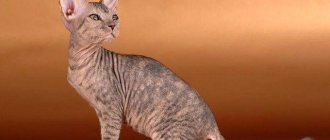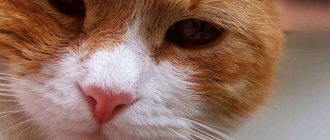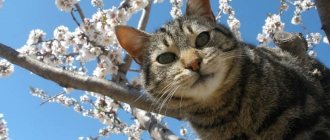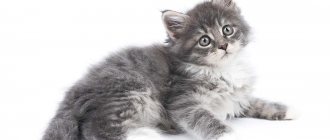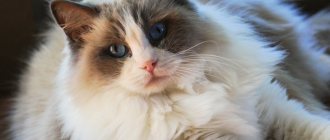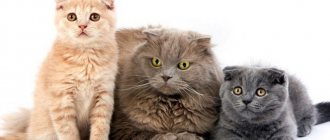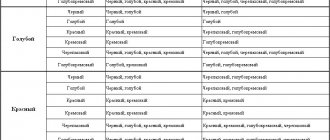At all times, rat-catching cats were highly valued by humans. This is due to the fact that, despite a highly developed hunting instinct, most purrs prefer to see mice and small birds as prey, and avoid rats. However, rats are the most dangerous pests that live side by side with people.
They not only steal food and gnaw everything, causing considerable damage, but can also attack humans, especially small children. Considering that rats carry many diseases, their bite can cause death. They also cause a lot of trouble to agriculture.
What cats catch mice and rats
Many owners living in the private sector are specifically looking for mousecatchers. However, identifying them is not always easy. Some rely on genetics. In other words, if the mother was a mousetrap cat, then the kitten will inherit her gift. Another option is breed.
Mousecats are especially needed in private homes
There is no doubt that certain members of the cat family have a greater propensity for catching rats or mice. However, there are other ways to determine which cats are better at catching rats and mice.
How to identify a rat-catcher cat
The first thing you should pay attention to is the color of the animal. Representatives with gray, black, brown, or red skin blend better with nature and, as a result, are more successful hunters. White, unfortunately, in this case, is the most losing.
The second point is education. It is very important how the kitten behaved in childhood. Outdoor games with a bow, a ball, chasing the light of a laser pointer - all this is the preparation and development of hunting instincts.
For your information! Yard cats and female cats are excellent mousecatchers. The point is also that they develop their instincts from childhood. Hunting for them is a way to survive.
An equally interesting question is whether the rat-catcher cat will continue to hunt after castration. The animal's behavior changes after this operation, but this does not mean that it will lose its innate and developed instincts. The only thing you should be careful of in this situation is overfeeding your pet. Such measures often lead to obesity, and, as a result, hunting skills decrease. Therefore, a neutered cat should be given a special diet, so that he will continue to perform the task assigned to him.
Russian blue
The average size of the breed sometimes gives reason to doubt the abilities of the rat catcher. But the Russian Blue has a secret weapon - quick reaction and the ability to move without making noise.
Features:
- instant reaction to moving targets;
- grace and precision of movements;
- speed before throwing.
If anyone has been able to observe the manners of a Russian Blue during a hunt, he compares mannerisms with art. Generation after generation, representatives of the breed confirm their primacy among rat catchers. If the Russian Blue lives in the house, there will not be problems with rodents for long.
British Fold cat breed
Kurilian Bobtail
Russian blue cat
Who is better at catching: a cat or a cat?
The cat is drooling: the main causes and treatment options
The question of who is better at catching mice and rats, a cat or a cat, also often worries owners who are planning to take an animal into the house. You might think that females are better hunters due to their developed maternal instinct. Indeed, a girl must provide food not only for herself, but also for her kittens. In addition, the cat’s genetics is less about hunting and more about procreation. The male must find and fertilize the female, so the hunter's instinct is slightly less developed in him.
Important! If a rat-catcher cat appears in the house, owners should take one point into account. Felines can deal not only with pests (moles, mice, rats, snakes), but also with some poultry, such as ducklings and chickens. In this case, the animal should be raised correctly.
Masking color
Peculiarities
Ratcatcher cats differ from their counterparts in a number of ways. Obviously, the main one is a pronounced hunting instinct. However, in addition to this characteristic, there are a number of other features that must be taken into account.
- Thus, scientists, veterinarians, as well as breeders note the fact that there is a well-defined gender difference in the manifestation of the hunting instinct in cats. Cats are considered more effective rat catchers than cats. The thing is that nature instills in females the awareness that they must feed not only themselves, but also their offspring, therefore, in terms of obtaining food, they act more actively and consciously.
- Also, those cats that catch mice and rats differ from their counterparts in the shape and structure of their heads . It is believed that animals with a skull whose outline is close to triangular are more capable of hunting than others.
- The presence of high tufted ears and a bushy mustache is another sign of a rat catcher. This anatomical structure ensures high sensitivity: the hairs react to any, even the slightest, air vibrations.
- Bright and variegated color may also indicate that cats are hunters . This coloring plays the role of a kind of camouflage and helps animals catch rodents.
It is necessary to take into account that the more signs described above you observe in a particular individual, the better it will cope with catching rats and mice.
With such a hunter in your house, you don't need mechanical mousetraps.
This is interesting: Signs of rabies in humans after a cat bite
The main signs of a rat catcher and a mouse catcher
Should you pay attention to the appearance of the animal? Many people believe that rat-catching cats stand out among their relatives. This is both a true and a false opinion.
The cat attacks the owner: the main reasons and options for what to do
Almost every member of the cat family can be made an excellent hunter if its external characteristics meet the requirements. First of all, you should pay attention to the color of the animal. It shouldn't be too bright. The most suitable colors are black, gray, striped.
It is believed that the most suitable huntresses are females with three colors (black, red and gray). There is also an opinion that a good hunter must have large ears and short hair. The latter is a really well-known fact. Among the long-haired rat-catching cats, the following breeds stand out: Turkish Angora, Norwegian Forest, Siberian, Maine Coon. As a rule, a fluffy coat is more of a hindrance to the hunter.
The shape of the head is another thing to pay attention to. Mousecatchers have a triangular head. It is also believed that large ears, especially with tufts, are another striking sign of a good hunter.
A few tips regarding selection, what you should pay attention to when choosing a kitten for hunting rats and mice:
- First of all, it should be remembered that the rat is a very large animal, therefore the hunter himself must be of rather large size. He must have well-developed muscles and skeleton. Powerful jaws are also very important. It should also be remembered that a lazy, immobile cat cannot perform the function of a hunter;
- The breed of rat-catcher cats is of great importance. In this matter, you cannot choose artificially bred representatives. Such selection negatively affects skills and dulls natural instincts;
- picking up an animal from the street does not mean you are guaranteed to get a rat catcher. Most street purrs are abandoned pets. Therefore, no one will give any guarantees;
- The best chance of getting a good hunter is to take a grown baby (3-4 months) from a rat-catcher mother. It's not just a matter of genetic predisposition. In the first months of life, the mother teaches her babies all the necessary skills, coupled with natural instincts. This is why you should give preference to already grown kittens;
- The cat's head should be a triangle. To accurately check, you need to press the animal's ears. Why is this worth paying attention to? This is how the hunter gene manifests itself in nature.
Important! You should remember to take care of your pet hunter. If an animal has been bitten by a rat, it must be taken to a veterinarian to be tested and given injections in case of rabies infection.
What does a triangular muzzle mean?
Some selection tips
To help those who want to purchase or raise a pet hunter, here are some recommendations:
- A rat is a large rodent. Accordingly, the cat must have a developed skeleton, muscles, and strong jaws. A lazy animal will not be able to hunt. A cat's body size is based on muscles, not layers of fat.
- When choosing a breed, you need to consider natural (aboriginal) varieties. Artificial selection greatly reduces skills. Those cats that owe their origin to wild ancestors are more ready for hunting. Many consider barn cats to be champions in catching rodents. The strongest individuals survive in the natural struggle for existence.
- Any cat on the street does not have to be a rat catcher. Many of them are former pets, who, by chance or by their owners, live in basements and entrances.
- One way to find a skilled hunter is to take an older kitten from a mother rat catcher. The cat teaches children, they are given abilities coupled with natural instinct. There is no need to adopt kittens when they are small. It takes time to learn and mature.
Chartreuse
Russian blue cat
American Wirehair cat
Important ! If a rat bites you, you need to help your cat. The veterinarian will treat the bite site and give an injection. It is easier to prevent the problem and get your pet vaccinated on time.
The cat’s external characteristics will help you choose:
- The head should look like a triangle. You can check this way - press the fur and ears to the head. It's not just a form. The gene responsible for instinct works together with the genes responsible for the shape of the skull.
- The presence of large ears with tassels and long mustaches. During the hunt, the animal senses any sound or rustle with these hairs based on the vibration of the air.
- A tricolor cat catches rats and sneaks up unnoticed. Only females can boast of this. Cats with black, gray or white fur are well camouflaged in nature.
The gender of your pet also matters a lot. Natural instinct is more developed in the “weaker sex”. The cat, guarding the kittens, gets food and is the first to begin a fight with the enemy. It has been noticed that out of 10 animals that know how to win, nine will be cats, the male will be the only one.
Popular rat catcher breeds
Metis cat: main options for variety of crossbreeds
As already mentioned, in the matter of choosing an animal for catching rodents, the breed is not the least important. There are a number of felines that are endowed with a strong hunter gene. If we consider purely physical data, they will differ in the above characteristics.
Russian blue
One of the most prominent representatives. The Russian Blue is not one of those who will sit in ambush for hours and watch its prey. She attacks quickly and swiftly, almost always overtaking her target.
Do not be deceived by their affectionate and gentle nature. Representatives of this breed are really gentle towards their owners, they can run after them around the house, tolerate them and even play with children. All this is a manifestation of an aristocratic nature. They are really very affectionate and sociable, they love to make new acquaintances. However, the animal is very capricious. It will not allow itself to be stroked if it does not want to.
Russian Blue has a good upbringing. A cat will rarely allow itself to scratch furniture and wallpaper, or stir up flowers. Representatives of this breed have a good memory. Having learned to hunt once, they will do it constantly.
Russian blue
Siberian rattrap
The rat-catcher cat of the Siberian breed can reach a weight of 9 kg. Females grow up to 6-7 kg. The breed is literally designed to destroy large pests.
Siberian cats have good health, well-developed muscles, powerful paws and an elongated neck. Their thick, long fur has a dark, striped color. These are one of the few long-haired representatives that are excellent hunters.
Siberian cats easily and quickly overtake their prey, and their long claws do not allow it to escape. They are very patient and can stalk their prey for hours, waiting for the best moment.
In relationships with people they prefer to maintain a distance. They are not as trusting and attached to humans as other breeds. The Siberian cat easily gets used to any change of environment, therefore, even if the pet is moved to a private house, it will quickly get used to it there.
Important! The Siberian breed does not require special care. A distinctive feature is that they need regular walks in the fresh air (even in winter).
Maine Coon
The Maine Coon is a breed that was originally bred to control rodents and other pests. The main advantage is their size. Such dimensions help to fight even the largest enemy. They are fluffy and come in a wide variety of colors. A characteristic feature of this breed are medium-sized straight ears with a tassel at the tip.
Maine Coons have a good memory and are quite intelligent. They willingly make contact with people and are amenable to training. They are not bothered by the presence of a child or other animal in the house.
For your information! The most interesting thing is that Maine Coons can get along with domestic rodents (like hamsters), but at the same time catch pests.
Maine Coons do not like confined spaces; they need freedom, a place to play and run. Therefore, it is best to keep such large animals in a private home. It is also worth remembering the special care that representatives of this breed require.
Awesome Maine Coon cat
Short-tailed Cymric
Cymric is not known for its large size. The main difference is that they almost completely lack a tail. This feature resulted from incest. However, such moments do not prevent Cymrik cats from being the best hunters. Experienced breeders recommend keeping representatives of this breed in spacious premises. This is exactly what a private home is, where they can fully realize their potential and splash out their energy.
Despite the lack of a tail, the Cymrik is distinguished by a very agile body and long llamas. The hunter quickly and easily overtakes his prey.
Note! Cymrik has been a rat catcher since birth.
Cymric
European Shorthair
Representatives of this breed are often confused with yard murziks. According to historical data, the European Shorthair comes from Ancient Rome and even then established itself as an excellent hunter.
Representatives of this type of cat are individual, have aristocratic features and a very independent disposition. They live with people as neighbors and really don’t like it when someone violates their personal space.
The color is silver marbled or gray. They love a lot of space, but can live in a city apartment. Quite unpretentious in care.
Important! They prefer to keep their distance from other animals and children.
Kurilian Bobtail
Representatives of this breed appeared in Russia relatively recently (at the beginning of the 20th century). These animals were brought from the Kuril Islands. Very affectionate and devoted to people. Their character traits are reminiscent of dogs.
Why are they good hunters? Precisely because of his affection. Even as a kitten, the Kurilian Bobtail tries in every possible way to please its beloved owner. Therefore, it is worth preparing for the fact that all the caught prey will be brought home and demonstratively eaten.
The breed is distinguished by a small tail and body, similar in structure to a lynx. The hind legs are longer and more powerful, which allows them to quickly gain speed when chasing prey.
Note! Adults are far from small in size. Males weigh up to 10 kg, and females 6-7 kg. However, the large dimensions will not prevent the hunter from getting prey even from the smallest hole.
Kurilian Bobtail
Siamese
Despite the peculiarity of their color (usually light), Siamese cats are also good hunters. However, in this case, the animal will need to be raised from small claws. While the baby is still small, it is necessary to play outdoor games with him as often as possible, to force him to chase an object. Also, don’t forget about encouragement. The animal must be praised for every prey caught (even if it is just a candy wrapper).
Note! You cannot starve an animal, otherwise it will not become a hunter. The most that a person will achieve with such behavior is to force the cat to climb into the trash can.
Siamese cats are loyal in their own way and are not as aggressive as is commonly believed. However, the animal chooses only one owner, and treats other people with a degree of disdain and condescension.
The hunting instinct in Siamese cats is naturally developed. No one has had a hand in breeding this breed, and this has its undoubted advantage. This instinct is transmitted at the genetic level and strengthened in kittens by their mother.
Siamese cats can track prey for a long time. Their large ears and long mustaches serve their owners well. A flexible, trained body is also a good assistant in hunting.
For your information! There is a story circulating on the Internet that a special breed of cat rats has been bred that is capable of catching rodents in one or two minutes. In fact, these are old photos of an unsuccessful cross between a Sphynx and a barn cat. The spectacle, I must say, is not a pleasant one. The resulting “breed” is a cat, similar to a rat.
The hunter's instinct is present in all cats, but do not forget about predisposition and natural data. When choosing a pet, you should give preference to strong, active representatives with a dull color, long ears and short hair.
Tool for combing the hair of cats and dogs My Rules (deshedder, comb, slicker) size M
711 ₽ More details
History of Russia for children. Book Butromeev V.P. | Butromeev Vladimir Petrovich
888 ₽ More details
Dog clippers
Maine Coon
The breed shows good skills in hunting pests in gardens, fields and cellars. They were often bred on farms where rodents were more likely to be present. The Maine Coon is one of the largest representatives of the cat family.
Characteristics:
- mobility;
- jump from a place over a long distance;
- passionate and hardy hunters;
- They tolerate bad weather well.
The endurance of Maine Coon cats is amazing; they are able to pursue prey for several hours. Large, weighing up to 15 kg, cats do not pay attention to weather changes. They are not bothered by cold or heat. Predators are able to hunt the largest rodents. Unlike others, Maine Coons do not like to lie on upholstered furniture for a long time. They prefer to be active most of the day. Large houses with a plot where they can hunt are suitable for them.
How to choose a rat hunter
The rat is a major pest that not every animal can cope with. The first thing you should pay attention to when choosing a cat is its build. Pets with powerful jaws and a strong and stocky body are best suited for hunting rodents.
Important. A big cat is not necessarily a good rat catcher. The body should be large not due to fat, but due to muscles.
Interestingly, cats, not cats, are considered the most merciless rodent hunters. Experts believe that this is due to maternal instinct: the cat sees rats as a potential danger to its offspring, even if these offspring do not exist.
Not all cat breeds are capable of catching rats.
On the Internet there are advertisements for the sale of kittens born from rat-catching cats. Buying such pets is a win-win option. Hunting skills are passed on to them with mother's milk and are developed at a conscious age, when the cat raises the babies and teaches them the wisdom of fighting rats. Naturally, a kitten cannot be taken away from its mother until it has mastered this complex art.
Kuril defender
The famous Kurilian Bobtails, despite their rather cute appearance, are excellent rat-catching cats. They are aggressive towards attackers, capable of repelling even the invasion of dogs into the territory they protect, and they deal mercilessly with rodents. Bobtails also love plenty of space to play around. In addition, they are well trained and are not at all afraid of water.
The breeds of cats that are good rat catchers also include the Kurilian Bobtail. The bobtail cat first appeared in Russia in the 20th century, when it was brought from the Kuril Islands. These animals are distinguished by their loyal nature to humans. In some ways they even resemble dogs in character.
Kurilian bobtail kittens immediately become attached to a person and try in every possible way to protect him from all sorts of troubles. The latter include rodents. By the way, in addition to mice and rats, bobtails are capable of driving away small dogs that have encroached on their territory.
The breed is distinguished by a small tail, the maximum size of which is only 8 cm. In body structure, these animals resemble a lynx: they have long and powerful hind limbs, allowing them to make excellent jumps. Kurilian bobtails are capable of running at high speed and crushing mice and rats.
The weight of these animals is up to 6 kg in females and up to 10 kg in males. Whatever the hole is - a mouse or a rat, the Kurilian Bobtail can cope with it; it is not without reason that they are often found on farms and in houses where rodent pests predominate.
There have also been cases of cats predicting earthquakes and gas leaks. The Kurilian Bobtail has the character of a warrior: bold and daring.
The peculiarity of the breed is its short tail, which grows only 3-8 cm in length. In return, the animal has limbs of a special structure: the hind legs are always more powerful and longer than the front ones, thanks to which the “domestic lynx” jumps well, runs quickly and crushes rats with ease. The color of a cat can be very different, with the exception of white, lilac and chocolate shades. Weight reaches 10 kg in males and 6 kg in females. The expert will tell you more about the breed in the next video.
We invite you to familiarize yourself with: Mating of British breed cats: how long they go during pregnancy, childbirth || Rules for breeding cats of the British breed
Bobtails can destroy entire mouse and rat holes, so they are most often kept outside the city, on farms and in other places where there are problems with rodents. These cats are trainable and amenable to training, so they do not cause problems for their owners. Companion cats easily find language with both humans and other pets.


